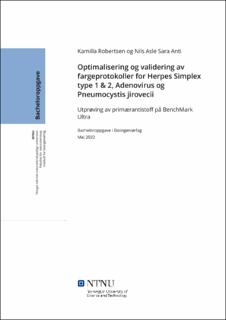| dc.contributor.advisor | Wålberg, Lise Eid | |
| dc.contributor.advisor | Grislingås, Asle | |
| dc.contributor.author | Robertsen, Kamilla | |
| dc.contributor.author | Anti, Nils Asle Sara | |
| dc.date.accessioned | 2022-06-30T17:20:13Z | |
| dc.date.available | 2022-06-30T17:20:13Z | |
| dc.date.issued | 2022 | |
| dc.identifier | no.ntnu:inspera:106147449:107341435 | |
| dc.identifier.uri | https://hdl.handle.net/11250/3001880 | |
| dc.description.abstract | Denne oppgaven ble gitt som en avsluttende bacheloroppgave for bioingeniørutdanningen ved Norges teknisk-naturvitenskapelige universitet (NTNU). Hensikten med prosjektet var å gjennomføre en optimalisering og validering av fargeprotokoller med primærantistoffer for Herpes Simplex type 1 og 2, Adenovirus og Pneumocystis jirovecii, slik at Avdeling for patologi kan innføre disse som en del av rutinediagnostikk. Protokollene ble optimaliser og validert på det immunhistokjemiske instrumentet BenchMark Ultra fra Ventana/Roche Diagnostics.
Nye fargeprotokoller for HSV-1 og HSV-2 vil gjøre det mulig å sette en slik diagnose med stor nøyaktighet og høy sikkerhet, ettersom en i dag bare kan kommentere på og PCR-resultater og sykdomsmanifestasjoner og hvordan disse er like for andre virus i herpesfamilien, deriblant Varicella Zoster-virus og Epstein-Barr. For Pneumocystis jirovecii kan en i dag gjennomføre diagnostikk via PCR, men nye fargeprotokoller vil kunne gi sikker innsikt i om P. jirovecii er årsaken til en sykdom, da ettersom mikroben kan maskeres i andre luftveissykdommer. Adenovirus ble ikke inkludert i utprøving av protokoller ettersom en manglet egnet prøvemateriale.
De protokoller som førte til resultater som var tydelige og pålitelige vil fortløpende bli en del av rutinediagnostikk. Gjennom utprøving ble det bestemt at RTU-primærantistoff for HSV-1 og HSV-2 i CC1-protokoll med 64 minutters forbehandlingstid gir resultater hvor en lett kan observere og identifisere virusets struktur og kjerne, samtidig som cellestrukturen til infiserte celler er tydelig. Protokollen blir tatt i bruk som en del av rutinediagnostikk.
For primærantistoff for Pneumocystis jirovecii ble det bestemt at en primærantistoffortynning på 1:25 i protokoll CC1 med 64 minutters forbehandlingstid gir optimale resultater. Resultatet av protokollen er tydelig markerte områder av P. jirovecii, samtidig som en unngår større mengder bakgrunnsfarging. Protokollen ga noe uspesifikk farging av blodkar og makrofager, og krever videre utprøving. Protokollen vil likevel bli tatt i bruk i rutinediagnostikk. | |
| dc.description.abstract | This thesis was given as the final assignment at Norges Teknisk-naturvitenskapelige universitet (NTNU) by the Faculty of Natural Sciences, Department of Biomedical Laboratory Science. The project’s purpose was to find new primary antibodies for Herpes Simplex type 1 and 2, Adenovirus, and Pneumocystis jirovecii. To do that, new staining protocols had to be made and optimized so they could be a part of diagnostic testing. This was done at the department for pathology, with BenchMark Ultra from Ventana/Roche Diagnostics, an immunohistochemical instrument.
New staining protocols for HSV-1 and HSV-2 would make it possible to accurately identify the diagnosis in question. The one currently used only reveals the PCR-results and manifestation, subsequently a comparison will be made to other viruses in the Herpesviridae family, like Varicella Zoster and Epstein-Barr. For the fungi Pneumocystis jirovecii a diagnosis can be made with PCR, but a new staining protocol will result in making it known if P. jirovecii is the cause of a disease. Adenovirus was lacking in samples and thus not included in the testing of new staining protocols.
Throughout the testing it was determined that the best protocol for HSV-1 and HSV-2 was with primary RTU-antibodies, and a pre-treatment with CC1 for 64 minutes. That gives results where the structure of both the virus and the infected cells are visible and easily identified, and thus the protocol was added to routine diagnostic testing.
For Pneumocystis jirovecii the best protocol was determined to have a primary antibody diluent of 1:25 with the pre-treatment CC1 for 64 minutes. The results show clearly defined areas with P. jirovecii while avoiding the most amount of background staining. However, the protocol did have some unspecific staining of blood vessels and macrophages. Thus, the protocol will require further testing, but will still be included to the routine diagnostic testing. | |
| dc.language | nob | |
| dc.publisher | NTNU | |
| dc.title | Optimalisering og validering av fargeprotokoller for Herpes Simplex type 1 & 2, Adenovirus og Pneumocystis jirovecii | |
| dc.type | Bachelor thesis | |
